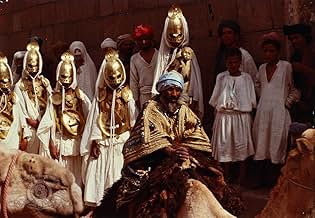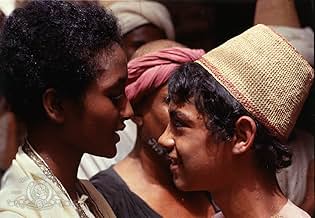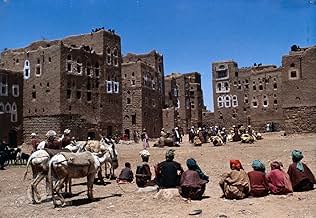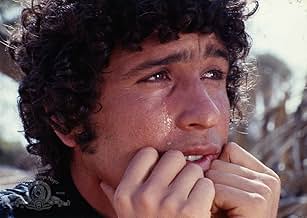IMDb RATING
6.6/10
9.6K
YOUR RATING
In ancient Arabia, a beautiful slave girl chooses a youth to be her new master, then she is kidnapped and they must search for each other. Stories are told within stories: love, travel and t... Read allIn ancient Arabia, a beautiful slave girl chooses a youth to be her new master, then she is kidnapped and they must search for each other. Stories are told within stories: love, travel and the whims of destiny.In ancient Arabia, a beautiful slave girl chooses a youth to be her new master, then she is kidnapped and they must search for each other. Stories are told within stories: love, travel and the whims of destiny.
- Awards
- 1 win & 3 nominations total
Tessa Bouché
- Aziza
- (as Tessa Bouche')
Margareth Clémenti
- Madre di Aziz
- (as Margaret Clementi)
Elisabetta Genovese
- Munis
- (as Elisabetta Vito Genovese)
- Director
- Writer
- All cast & crew
- Production, box office & more at IMDbPro
Featured reviews
"Fiore delle mille e una notte" ,which won special prize at CANNES 1974 is the third part of what Pasolini called the trilogy of life which encompasses "il decameron" (1971) and" racconti di Canterbury" (1972). It's the most accessible of all Pasolini movies ,and weren't it for the numerous nudities,it would appeal to large audience.
This must be the script:it's much better than the two first films because the story is built à la Shéhérazade ,with plots ,subplots and subsubplots which fit into each other;and although sex is the main vector,it features enough twists to sustain the interest throughout.It does not forget magic (the segment which features Ninetto Davoli,Pasolini's favorite actor,uses a lot of symbols)and mystery (the adolescent who must be killed when he's fifteen ).Humor is less vulgar than in "di racconti di Canterbury" The little riddle "the aromatic grass of the fields" "the slit pomegranate" and "the inn of the warm welcome " is witty.
Little did we know that Pasolini would follow his trilogy of life with the most depressing work ever made :"Salo" (1975).
This must be the script:it's much better than the two first films because the story is built à la Shéhérazade ,with plots ,subplots and subsubplots which fit into each other;and although sex is the main vector,it features enough twists to sustain the interest throughout.It does not forget magic (the segment which features Ninetto Davoli,Pasolini's favorite actor,uses a lot of symbols)and mystery (the adolescent who must be killed when he's fifteen ).Humor is less vulgar than in "di racconti di Canterbury" The little riddle "the aromatic grass of the fields" "the slit pomegranate" and "the inn of the warm welcome " is witty.
Little did we know that Pasolini would follow his trilogy of life with the most depressing work ever made :"Salo" (1975).
This was the penultimate film of the great Italian director Pier Paolo Pasolini. It also concludes his "Trilogy of Life", based on medieval story collections (the others are "The Decameron" and "The Canterbury Tales"). Like the others in the series, this is a portmanteau film (i.e. the film is not just one story but several).
The film begins with a young man's search for his slave girl lover, who has been abducted. Along the way, several stories from "The Arabian Nights" are told.
The film has a very loose structure. There are stories, within stories, within stories. This can be quite confusing at times. It was filmed in Iran, Yemen and Nepal and the countries look absolutely spectacular. The main flaw of the film is that it does show signs of being hastily cut (Pasolini himself reduced the film by half an hour before general release, and there may have been cuts due to the censors). This often makes the film seem quite disjointed. One of the dominant themes in this film is love and sex, and yes, there is a lot of explicit nudity here.
The film touches on dreams, reality, deception, truth, freedom and slavery. While by no means perfect, there are times when the Pasolini's genius and humanity shines through.
The film begins with a young man's search for his slave girl lover, who has been abducted. Along the way, several stories from "The Arabian Nights" are told.
The film has a very loose structure. There are stories, within stories, within stories. This can be quite confusing at times. It was filmed in Iran, Yemen and Nepal and the countries look absolutely spectacular. The main flaw of the film is that it does show signs of being hastily cut (Pasolini himself reduced the film by half an hour before general release, and there may have been cuts due to the censors). This often makes the film seem quite disjointed. One of the dominant themes in this film is love and sex, and yes, there is a lot of explicit nudity here.
The film touches on dreams, reality, deception, truth, freedom and slavery. While by no means perfect, there are times when the Pasolini's genius and humanity shines through.
Fun to see the comments at two extreme posts. There are things like durian and cheese, either you love it, or you hate it! So below is just my personal opinion and you absolutely don't need to agree with me!
It is true that the characters are quite caricatural, but the movie is about one thousand and one nights - it is about fantasies! Honestly i don't ever find the "dreams" typical of hollywoodian movies more appealing. it is just a matter of taste. in fact, through exaggerations, Pasolini let human strengthens and weaknesses magnified and incarnated in the characters. in a way, they are like cartoon characters. Can we call that bad acting? it is just a style of interpretation. Oh, only if we had the innocence like the actors and actress in the movie ... in fact, somehow i found a bit of resemblance (or to the opposite of it!) in these characters to people i know. only if you observe, man! I especially love the story about Aziz and Aziza...
It is above all a movie about love - and there comes sex naturally, and the jealousy, pain, loyalty, betrayal, etc. Even between the "owner" and the "slave", there was absolutely no slavery involves, but just love! well an exchange took place in the market, but that only showed that the slave was actually free. Pasolini didn't have an obsession for the female body which is usually the case in most movies. Is there anything wrong about that? Or are we just too accustomed to female nudity so we always expect it and we become annoyed about male nudity too easily? Both can be beautiful and deserve the same attention from the camera and the audience.
Talking about female vs. male in the movies, i constantly feel that Pasolini pictured man as a simple but too simple (even stupid) creature, while woman as complex and too complex (either a saint or perversed) when it comes to love. But again, it's about fairy tales. Only if it were true, life would be so much easier!
There were poems cited in almost every story and this was one of the most fascinating elements in the movie as well. you may call it erotic, but look at it another way round, who doesn't want his/her own sex and love life to be as poetic and beautiful. I see the humour in the movie with the same lens.
I was also amazed by the flow of the story line - story within a story, and then a personage in the story starts to tell another story... it can be confusing at first, but as the story flows it all became clearer, and at the end, i was simply amazed. or thanks to the DVD technology too, imagine 30 years back when u had to and could only watch it in one go in a cinema!
It is true that the characters are quite caricatural, but the movie is about one thousand and one nights - it is about fantasies! Honestly i don't ever find the "dreams" typical of hollywoodian movies more appealing. it is just a matter of taste. in fact, through exaggerations, Pasolini let human strengthens and weaknesses magnified and incarnated in the characters. in a way, they are like cartoon characters. Can we call that bad acting? it is just a style of interpretation. Oh, only if we had the innocence like the actors and actress in the movie ... in fact, somehow i found a bit of resemblance (or to the opposite of it!) in these characters to people i know. only if you observe, man! I especially love the story about Aziz and Aziza...
It is above all a movie about love - and there comes sex naturally, and the jealousy, pain, loyalty, betrayal, etc. Even between the "owner" and the "slave", there was absolutely no slavery involves, but just love! well an exchange took place in the market, but that only showed that the slave was actually free. Pasolini didn't have an obsession for the female body which is usually the case in most movies. Is there anything wrong about that? Or are we just too accustomed to female nudity so we always expect it and we become annoyed about male nudity too easily? Both can be beautiful and deserve the same attention from the camera and the audience.
Talking about female vs. male in the movies, i constantly feel that Pasolini pictured man as a simple but too simple (even stupid) creature, while woman as complex and too complex (either a saint or perversed) when it comes to love. But again, it's about fairy tales. Only if it were true, life would be so much easier!
There were poems cited in almost every story and this was one of the most fascinating elements in the movie as well. you may call it erotic, but look at it another way round, who doesn't want his/her own sex and love life to be as poetic and beautiful. I see the humour in the movie with the same lens.
I was also amazed by the flow of the story line - story within a story, and then a personage in the story starts to tell another story... it can be confusing at first, but as the story flows it all became clearer, and at the end, i was simply amazed. or thanks to the DVD technology too, imagine 30 years back when u had to and could only watch it in one go in a cinema!
This film version keeps much of the eroticism in Sir Richard Burton's original translation, which previous movie treatments saw fit to water down
Great care was taken in the details: it was shot on location (Africa and the Middle East) and a dark skinned girl was cast as the princess
The acting is extremely good, and the stories connect in and out in intriguing fashion...
The film selects some of the more popular of the Arabian Nights stories, but intertwines them in strange ways Like the original, many stories lead into other stories and again into others
One of the most erotic sequences is when two supernatural beings decide to play a trick on a virginal girl and boy The beings make each young person seduce the other while he or she is asleep In another scene, one of the heroes finds himself in a pool with a group of very pretty, very nude Arabian women, who tease and tickle him into an intense joy
The film selects some of the more popular of the Arabian Nights stories, but intertwines them in strange ways Like the original, many stories lead into other stories and again into others
One of the most erotic sequences is when two supernatural beings decide to play a trick on a virginal girl and boy The beings make each young person seduce the other while he or she is asleep In another scene, one of the heroes finds himself in a pool with a group of very pretty, very nude Arabian women, who tease and tickle him into an intense joy
Surely there's a lot to admire and enjoy in this movie: the settings and costumes are extremely colourful, the locations exotic, at times almost dreamlike, and at several times there are stunning mass-scenes. All this makes watching it a dazzling and overwhelming experience. But - at least with me - this movie also evokes bewilderment, confusion and irritation.
Using local amateurs can give a feeling of authenticity, but here is such an abundance of amateurism that it gets on your nerves. Many of the cast don't seem to act at all, but just obediently follow orders: they either loiter about or run around frantically, they grin sheepishly or feign to cry, they rattle their obviously later dubbed Italian lines in mostly loud and high-pitched voices, and then sooner or later (mostly sooner) they take their clothes off, that's about it. The musical score is very strange and uneven, at some parts beautiful music (Morricone!), at other times there are long streches of bland silence. Strangely enough never Arabian-sounding music, which couldn't have been hard to find around the locations where they filmed.
I don't mind a bit of nudity and sex, but this is really way over the top: every guy that pops around the corner is stark naked within a minute or two and runs around like that for the rest of the film. And mind you, this is a 1974 movie that actually won a renowned prize (in Cannes)! What on earth is the point of all this exhibitionism, there are numerous instances where there appears to be no functional motivation for it whatsoever.
Maybe Pasolini liked to create confusion and bewilderment. It's only a bit hard to admire this film for just that and for the enchanting cinematography.
Using local amateurs can give a feeling of authenticity, but here is such an abundance of amateurism that it gets on your nerves. Many of the cast don't seem to act at all, but just obediently follow orders: they either loiter about or run around frantically, they grin sheepishly or feign to cry, they rattle their obviously later dubbed Italian lines in mostly loud and high-pitched voices, and then sooner or later (mostly sooner) they take their clothes off, that's about it. The musical score is very strange and uneven, at some parts beautiful music (Morricone!), at other times there are long streches of bland silence. Strangely enough never Arabian-sounding music, which couldn't have been hard to find around the locations where they filmed.
I don't mind a bit of nudity and sex, but this is really way over the top: every guy that pops around the corner is stark naked within a minute or two and runs around like that for the rest of the film. And mind you, this is a 1974 movie that actually won a renowned prize (in Cannes)! What on earth is the point of all this exhibitionism, there are numerous instances where there appears to be no functional motivation for it whatsoever.
Maybe Pasolini liked to create confusion and bewilderment. It's only a bit hard to admire this film for just that and for the enchanting cinematography.
Did you know
- TriviaThis film is the final entry in director Pier Paolo Pasolini's "Trilogy of Life," following Le Décaméron (1971) and Les Contes de Canterbury (1972).
- GoofsWhen the chimpanzee is writing, it's clearly visible that it's not actually the chimp writing but an actor wearing a glove made to look like the chimp's hand.
- Crazy credits"Truth lies not in one dream, but in many." - Arabian Nights
- Alternate versionsThe 1990 Water Bearer Films video release (WBF 8001) is marked "Original Uncut Version" with a runtime of 133 min. It is rated X.
- ConnectionsEdited into Porn to Be Free (2016)
- How long is Arabian Nights?Powered by Alexa
Details
- Release date
- Countries of origin
- Languages
- Also known as
- Las mil y una noches
- Filming locations
- Mesjed-e-Imam, Esfahan, Iran(Zumurrud's palace)
- Production companies
- See more company credits at IMDbPro
Box office
- Gross worldwide
- $755
- Runtime2 hours 10 minutes
- Sound mix
- Aspect ratio
- 1.85 : 1
Contribute to this page
Suggest an edit or add missing content


























